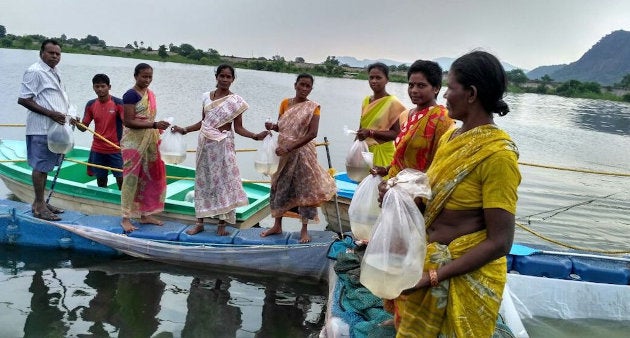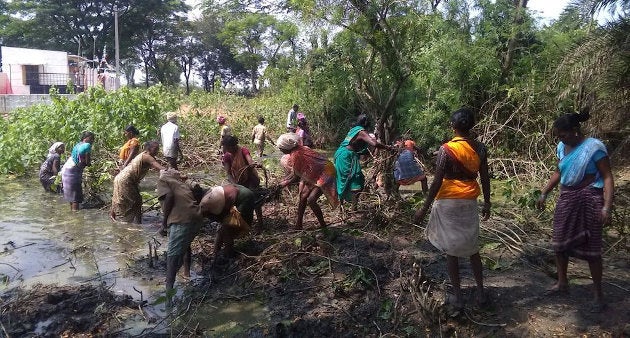The productivity of inland fisheries can be boosted massively if governments get out of the way of operations and let fish enterprises grow across India.

By Sanjiv Phansalkar*
For a protein-deficient country, the neglect of the inland fisheries sector in India is nothing short of criminal. The recorded area of tanks and ponds in India is 2.9 million hectares and the area under reservoirs is 2.1 million hectares. One may add to this the area under numerous wetlands in the eastern parts of the country with an approximate area of another 1 million hectares. From the 6 million hectares, the total reported production of inland fish in India is barely 6.1 million tonnes.
What's important is to recognise that the role of government is basically in designing intelligent lease agreements and enabling working capital supply.
This is about a sixth of what could be achieved if the ponds and tanks were converted from stagnant smelly waters to vibrant production centres of fish. The scope to utilise small household ponds in the eastern parts of the country also appears to be robust. At a rough guess, the country could be producing 25-30 million tonnes of fish from inland bodies against the current 6 million tonnes, an annual opportunity loss valued at over ₹4 trillion. Why is it that despite this potential gain, production enhancement does not happen?
Low productivity
The reasons can be broadly divided into three classes —resource quality issues; socio-economic issues around the resources; and techno-managerial issues connected with the production of fish. The resource quality issues pertain mainly to the length of time for which adequate water would be standing in a waterbody, alternate demands on the same waterbody and water quality problems resulting from these alternate demands.
Socioeconomic issues pertain to usufruct rights over the waterbodies; security and length of tenancy when these are leased; and poaching of fish. Techno-managerial issues pertain to the availability of spawn, seedlings and fingerlings on time, availability of necessary feed and medicines, access to markets and working capital. Let us look at these three issues and where and how have people overcome them.
In drought-prone areas, ponds acquire an adequate water depth by the end of the monsoons until the end of April. Thus fish production would be best done if this entire period were effectively used. The length of the productive period for wetlands starts from October end when the floods recede and continues till the end of May. Reservoirs are more reliable. The length of standing water in small household ponds etc. is also a function of monsoons but water in these can be augmented much more easily.
Multiple uses
There is a major issue with ponds and tanks in most parts of the mainland in India —these are typically multiple-use waterbodies. Humans and animals bathe there, utensils and clothes are washed there, they are used for swimming etc. In South India, the tanks are essentially looked upon as sources of irrigation and regulated by the famous office of the neer-katti. These multiple-use waterbodies, therefore, are unreliable for fish production unless managed well. There often is the nub.

Socio-economic issues arise because a bulk of the water bodies is common or at least public goods regulated by the local self-government agencies. Gram panchayats govern them if they are smaller than 100 hectares in size and the district level bodies govern them if they are larger. Guidelines in most states require these governing bodies to allot the fishing rights to the dead or fictitious co-operatives of the fishermen (or other marginalized and Dalit) communities. In most places, such co-operatives are poorly managed. Since the ponds have a perimeter that could exceed a few kilometers, guarding the pond fish against poachers at night is a tough proposition and seldom acted upon by these co-operatives.
Socio-economic issues arise because a bulk of the waterbodies is common or at least public goods regulated by the local self-government agencies. Gram panchayats govern them if they are smaller than 100 hectares in size and the district-level bodies govern them if they are larger. Guidelines in most states require these governing bodies to allot the fishing rights to dead or fictitious cooperatives of the fishermen or other marginalised and Dalit communities. In most places, such cooperatives are poorly managed. Since the ponds have a perimeter that could exceed a few kilometres, guarding the pond fish against poachers at night is a tough proposition and seldom acted upon by these cooperatives.
Techno-managerial imbalances
Techno-managerial issues are similar in texture to issues of any commercial activity. There is an imbalance between the number of hatcheries capable of giving quality seedlings and the area in which these may be grown. Like most other forms of farm activities (backyard poultry, raising small and large ruminants), people are used to treating fisheries too as near zero input enterprises. As such, efficient markets for the supply of inputs such as feed have not come up.
Fisheries departments are intent on schemes for spending money on creating infrastructure (which then does not function) or give subsidies that are often wasted.
The market for fresh fish itself is so grossly underserved that downstream processing is absent for inland fisheries. And there is the universal absence of formal working capital arrangements with banks for funding smooth and efficient fisheries on business principles.
Some interesting but location-specific efforts have shown that the production potential can be realised. Gujarat shifted from an insistence on cooperatives as lessees of ponds and tanks to a public auction and changed the tenure of lease from a single year to several years. This created a huge incentive to the entrepreneurs. This alone increased the production manifold since private entrepreneurs found a way to strengthen the ponds, to replenish water when it started drying up, to manage the demands for alternate uses by making suitable arrangements that would not damage fish, and to spend money for protection against poachers.
Cage fisheries
Cage fisheries in large reservoirs seem to be yielding good results in Jharkhand and Andhra Pradesh. The massive thriving enterprises of Koleru are a testimony to the ease with which techno-managerial issues can be solved. What's important is to recognise that the role of government is basically in designing intelligent lease agreements and enabling working capital supply.
The trouble is, rather than doing that, fisheries departments are intent on schemes for spending money on creating infrastructure (which then does not function) or give subsidies that are often wasted. Because this sort of engagement makes both the bureaucracy and the ministers in charge feel they are doing something.
Will the government get out of the way in operations, just stick to setting tenancy rules and let fish and fish enterprises grow? On the answer to that question hinges the fate of the blue revolution.
Sanjiv Phansalkar is Programme Director at Tata Trusts. He was earlier a faculty member at the Institute of Rural Management Anand (IRMA). Phansalkar is a fellow of the Indian Institute of Management (IIM) Ahmedabad.
This article was first published on VillageSquare.in, a public-interest communications platform focused on rural India.
